tyre pressure Citroen DS5 HYBRID4 RHD 2014 1.G Owner's Manual
[x] Cancel search | Manufacturer: CITROEN, Model Year: 2014, Model line: DS5 HYBRID4 RHD, Model: Citroen DS5 HYBRID4 RHD 2014 1.GPages: 382, PDF Size: 14.52 MB
Page 11 of 382

9Familiarisation
For economical driving, caring for the environment
The fuel consumption of a vehicle varies greatly : - according to the driver's style of driving (moderate, aggressive, fast, ...), - according to the type of journeys made (urban, main road, motor way, flowing, heavy traffic, …) and the speed.
Main recommendations for driving economically
Hybrid mode selector
To optimise fuel consumption, use the Auto mode of the selector whenever possible (the mode is activated automatically when starting) including for urban journeys. This mode optimises the use of the energy sources (internal combustion engine and/or electric) contrary to other modes, which are for use in particular cases.
Gear lever
Use the automatic mode A as much as possible as this optimises gear changes to suit the requirements.
Causes of high consumption and checks
As with any vehicle, limit overloading, wind resistance (windows open above 30 mph (50 km/h), roof bars, loaded or not, …), the use of power consumers (air conditioning, heated seats, heated rear screen, …). Observe the recommendations on checks (regular check of tyre pressures, correct tyre pressures, …) and routine servicing.
Drive smoothly
Stay in the "eco" zone displayed in the energy consumption / generation indicator: accelerate gently, drive at steady speeds using the speed limiter or cruise control as soon as possible. Use the "charge"zone: anticipate the need to slow down by taking your foot off the accelerator rather than braking. The movement of the energy consumption / generation indicator needle (into the "charge" zone), shows the level of energy recovery.
Consumption history
See the impact of your style of driving and the type of journey by reviewing the history of your energy consumption. Refer to the "Multifunction screens" section.
Page 13 of 382
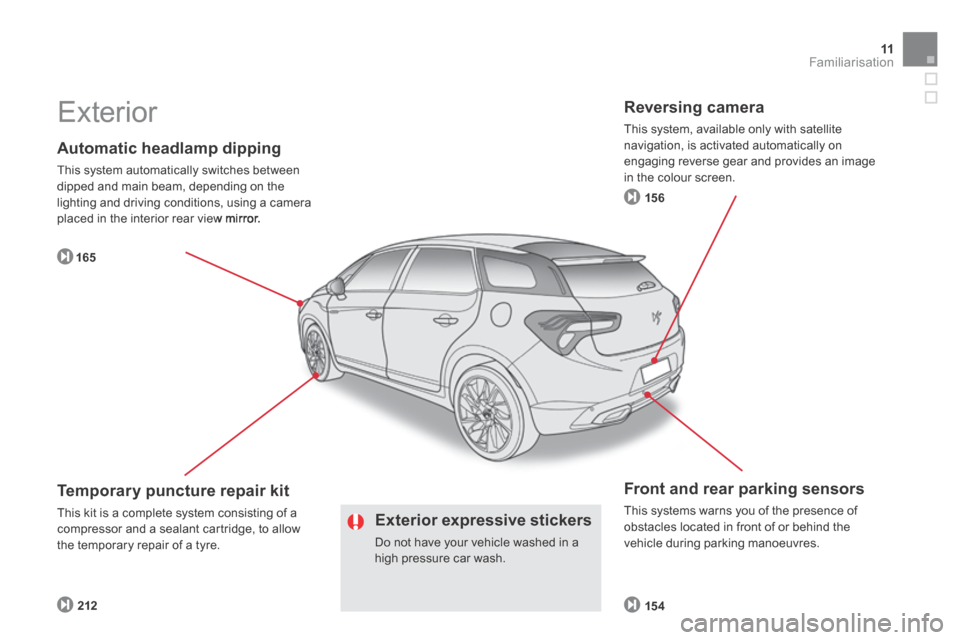
11Familiarisation
Automatic headlamp dipping
This system automatically switches between dipped and main beam, depending on the lighting and driving conditions, using a camera placed in the interior rear view mirror. placed in the interior rear view mirror.
165
Front and rear parking sensors Front and rear parking sensors
This systems warns you of the presence of obstacles located in front of or behind the vehicle during parking manoeuvres.
15 4
Temporary puncture repair kit
This kit is a complete system consisting of a compressor and a sealant cartridge, to allow
the temporary repair of a tyre.
Exterior expressive stickers
Do not have your vehicle washed in a high pressure car wash.
212
Exterior Reversing camera
This system, available only with satellite navigation, is activated automatically on engaging reverse gear and provides an image in the colour screen.
15 6
Page 50 of 382
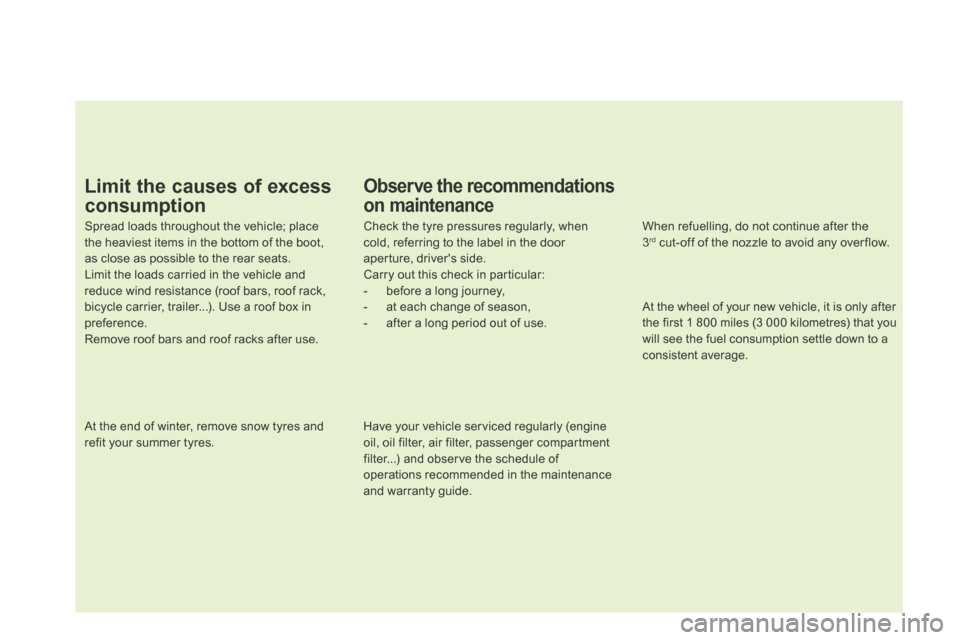
Observe the recommendations
on maintenance
Check the tyre pressures regularly, when cold, referring to the label in the door aperture, driver's side. Carry out this check in particular: - before a long journey, - at each change of season, - after a long period out of use.
Have your vehicle serviced regularly (engine oil, oil filter, air filter, passenger compartment filter...) and observe the schedule of operations recommended in the maintenance and warranty guide.
When refuelling, do not continue after the 3 rd cut-off of the nozzle to avoid any over flow.
At the wheel of your new vehicle, it is only after the first 1 800 miles (3 000 kilometres) that you will see the fuel consumption settle down to a consistent average.
At the end of winter, remove snow tyres and refit your summer tyres.
Spread loads throughout the vehicle; place the heaviest items in the bottom of the boot, as close as possible to the rear seats. Limit the loads carried in the vehicle and reduce wind resistance (roof bars, roof rack, bicycle carrier, trailer...). Use a roof box in preference. Remove roof bars and roof racks after use.
Limit the causes of excess
consumption
Page 70 of 382

Low fuel level fixed with the two last bars flashing, accompanied by a message and an audible signal.
When it first comes on there remains approximately 6 litres of approximately 6 litres of approximately 6 litres offuel in the tank.
You must refuel as soon as possible to avoid running out of fuel. This warning lamp will come on every time the ignition is switched on, accompanied by a message and an audible signal, until a sufficient addition of fuel is
made. This audible signal and message are repeated with increasing frequency as the fuel level drops and approaches "0". Fuel tank capacity: approximately 60 litres. Never continue to drive until you run out of fuel as this could damage the emission control and injection systems.
Warning / indicator lampStateCauseAction / Observations
Under-inflation fixed. The pressure in one or more wheels is too low. Check the pressure of the tyres as soon as possible. This check should preferably be carried out when the tyres are cold.
+ flashing then fixed, accompanied by the Service warning lamp.
The tyre pressure monitoring system has a fault or no sensor is detected on one of the wheels.
Under-inflation detection is not assured. Have the system checked by a CITROËN dealer or a qualified workshop.
Page 146 of 382

Tyre under-infl ation detection
System which automatically checks the pressures of the tyres while driving. The system continuously monitors the pressures of the four tyres, as soon as the vehicle is moving. A pressure sensor is located in the valve of a each tyres (except the spare wheel). The system triggers an alert if a drop in pressure is detected in one or more tyres.
This system does not avoid the need to check the tyre pressures regularly (including the spare wheel) and before a long journey. Driving with under-inflated tyres
adversely affects road holding, extends braking distances and causes premature tyre wear, particularly under arduous conditions (vehicle loaded, high speed, long journey).
The tyre pressures for your vehicle can be found on the tyre pressure label (see the "Identification markings" section). The tyre pressures must be checked when the tyres cold (vehicle stopped
for 1 hour or after driving for less then 6 miles (10 km) at moderate speed). Other wise, add 0.3 bar to the values indicated on the label.
Driving with under-inflated tyres increases fuel consumption.
The tyre under-inflation detection system is an aid to driving which does not replace the need for the driver to be vigilant or to drive responsibly.
Page 147 of 382
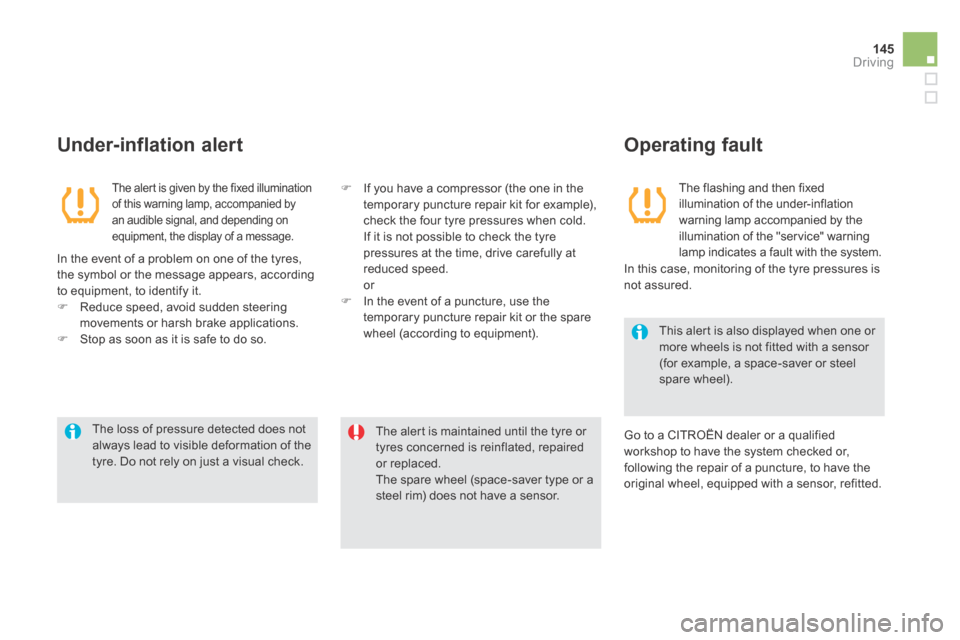
145Driving
The alert is maintained until the tyre or tyres concerned is reinflated, repaired or replaced. The spare wheel (space-saver type or a steel rim) does not have a sensor.
The loss of pressure detected does not
always lead to visible deformation of the tyre. Do not rely on just a visual check.
This alert is also displayed when one or more wheels is not fitted with a sensor (for example, a space-saver or steel spare wheel).
The alert is given by the fixed illumination of this warning lamp, accompanied by an audible signal, and depending on equipment, the display of a message.
The flashing and then fixed illumination of the under-inflation warning lamp accompanied by the illumination of the "service" warning lamp indicates a fault with the system.
Under-inflation alert Operating fault
In the event of a problem on one of the tyres, the symbol or the message appears, according to equipment, to identify it. Reduce speed, avoid sudden steering movements or harsh brake applications. Stop as soon as it is safe to do so.
Go to a CITROËN dealer or a qualified workshop to have the system checked or, following the repair of a puncture, to have the original wheel, equipped with a sensor, refitted.
In this case, monitoring of the tyre pressures is not assured.
If you have a compressor (the one in the temporary puncture repair kit for example), check the four tyre pressures when cold. If it is not possible to check the tyre pressures at the time, drive carefully at reduced speed. or In the event of a puncture, use the temporary puncture repair kit or the spare wheel (according to equipment).
Page 201 of 382
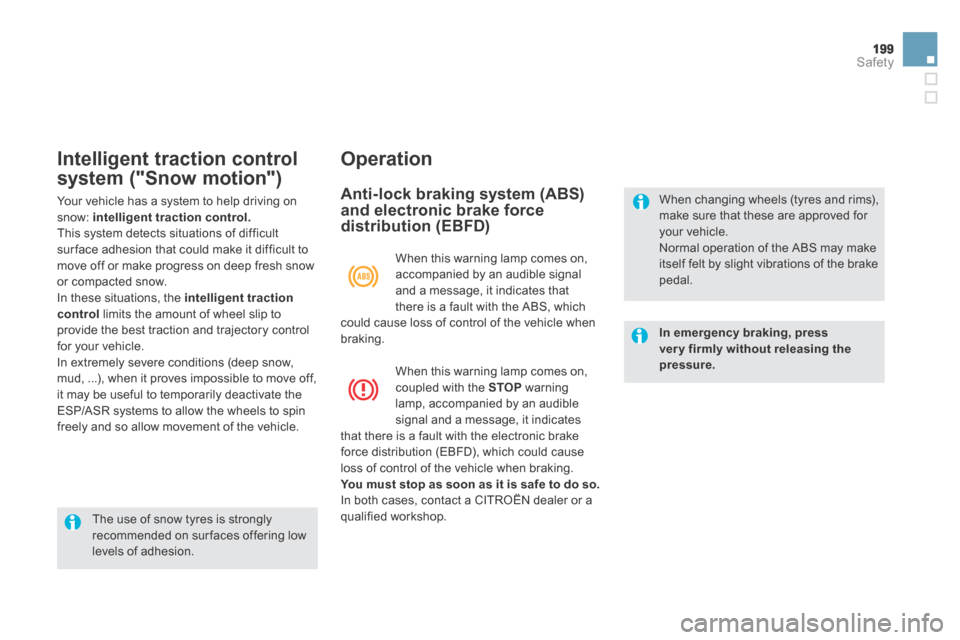
199Safety
Intelligent traction control
system ("Snow motion")
Your vehicle has a system to help driving on snow: intelligent traction control.
This system detects situations of difficult sur face adhesion that could make it difficult to move off or make progress on deep fresh snow or compacted snow. In these situations, the intelligent traction control limits the amount of wheel slip to provide the best traction and trajectory control for your vehicle. In extremely severe conditions (deep snow, mud, ...), when it proves impossible to move off, it may be useful to temporarily deactivate the ESP/ASR systems to allow the wheels to spin freely and so allow movement of the vehicle.
Operation
Anti-lock braking system (ABS) and electronic brake force distribution (EBFD)
In emergency braking, press very firmly without releasing the pressure.
When changing wheels (tyres and rims), make sure that these are approved for your vehicle. Normal operation of the ABS may make itself felt by slight vibrations of the brake pedal.
When this warning lamp comes on, accompanied by an audible signal and a message, it indicates that there is a fault with the ABS, which could cause loss of control of the vehicle when braking.
When this warning lamp comes on, coupled with the STOP warning lamp, accompanied by an audible signal and a message, it indicates that there is a fault with the electronic brake force distribution (EBFD), which could cause loss of control of the vehicle when braking. You must stop as soon as it is safe to do so. In both cases, contact a CITROËN dealer or a qualified workshop. The use of snow tyres is strongly recommended on sur faces offering low levels of adhesion.
Page 214 of 382
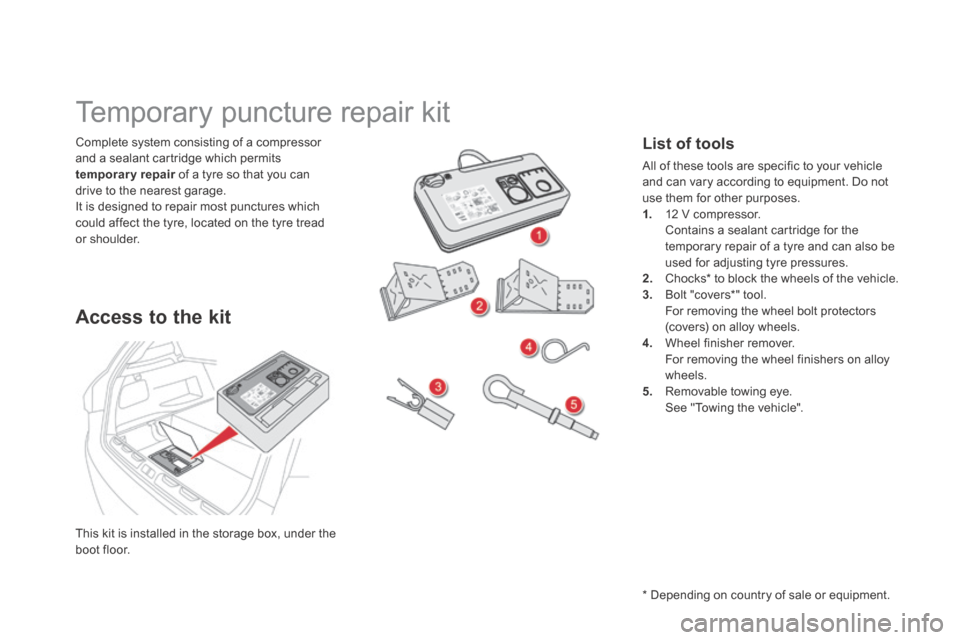
This kit is installed in the storage box, under the boot floor.
Complete system consisting of a compressor and a sealant cartridge which permits temporary repair of a tyre so that you can temporary repair of a tyre so that you can temporary repairdrive to the nearest garage. It is designed to repair most punctures which could affect the tyre, located on the tyre tread or shoulder.
Temporary puncture repair kit
Access to the kit
List of tools
All of these tools are specific to your vehicle and can vary according to equipment. Do not use them for other purposes. 1. 12 V compressor. Contains a sealant cartridge for the temporary repair of a tyre and can also be used for adjusting tyre pressures. 2. Chocks * to block the wheels of the vehicle. 3. Bolt "covers * " tool. For removing the wheel bolt protectors (covers) on alloy wheels. 4. Wheel finisher remover. For removing the wheel finishers on alloy wheels. 5. Removable towing eye. See "Towing the vehicle".
* Depending on country of sale or equipment.
Page 215 of 382
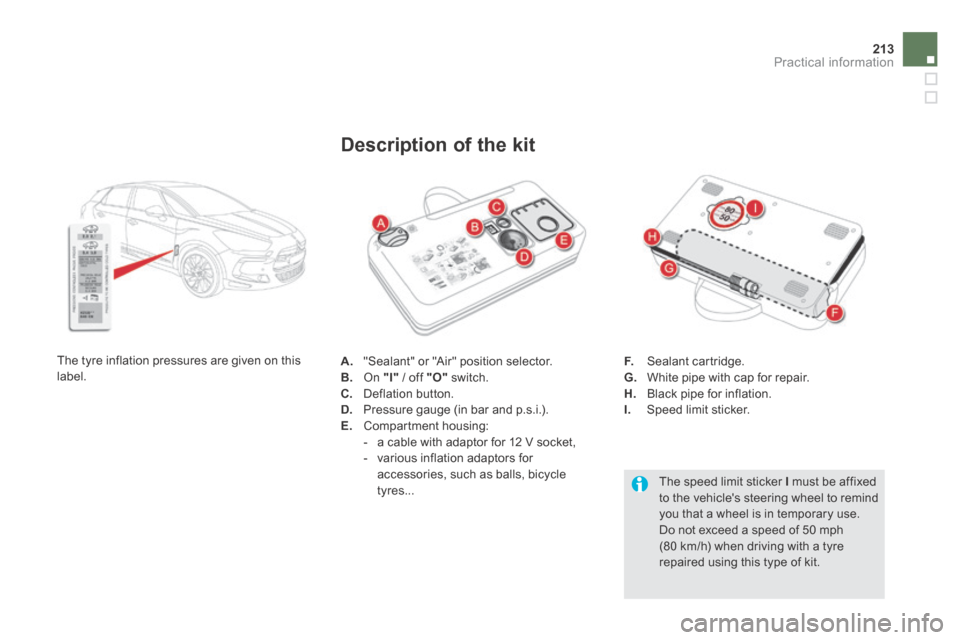
213Practical information
A. "Sealant" or "Air" position selector. B. On "I" / off "O" switch. C. Deflation button. D. Pressure gauge (in bar and p.s.i.). E. Compartment housing: - a cable with adaptor for 12 V socket, - various inflation adaptors for accessories, such as balls, bicycle tyres...
Description of the kit
F. Sealant cartridge. G. White pipe with cap for repair. H. Black pipe for inflation. I. Speed limit sticker.
The speed limit sticker I must be affixed to the vehicle's steering wheel to remind you that a wheel is in temporary use. Do not exceed a speed of 50 mph (80 km/h) when driving with a tyre repaired using this type of kit.
The tyre inflation pressures are given on this label.
Page 217 of 382
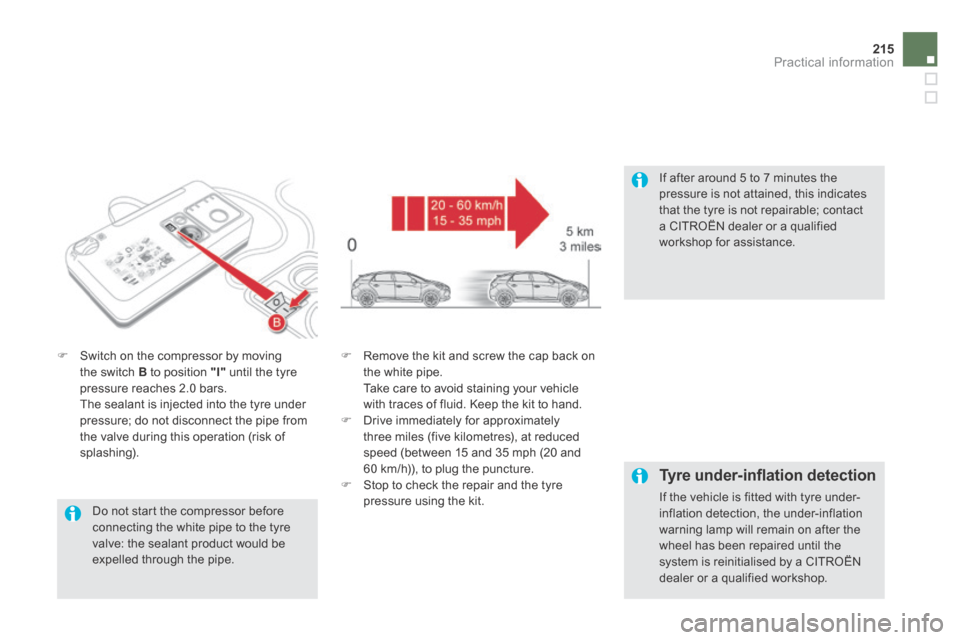
215Practical information
Do not start the compressor before connecting the white pipe to the tyre valve: the sealant product would be expelled through the pipe.
Switch on the compressor by moving the switch B to position "I" until the tyre pressure reaches 2.0 bars. The sealant is injected into the tyre under pressure; do not disconnect the pipe from the valve during this operation (risk of splashing).
Remove the kit and screw the cap back on the white pipe. Take care to avoid staining your vehicle with traces of fluid. Keep the kit to hand. Drive immediately for approximately three miles (five kilometres), at reduced speed (between 15 and 35 mph (20 and 60 km/h)), to plug the puncture. Stop to check the repair and the tyre pressure using the kit.
Tyre under-infl ation detection
If the vehicle is fitted with tyre under-inflation detection, the under-inflation warning lamp will remain on after the wheel has been repaired until the system is reinitialised by a CITROËN dealer or a qualified workshop.
If after around 5 to 7 minutes the pressure is not attained, this indicates that the tyre is not repairable; contact a CITROËN dealer or a qualified workshop for assistance.